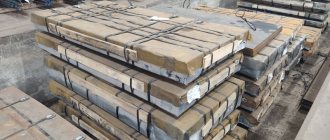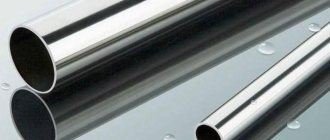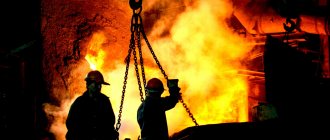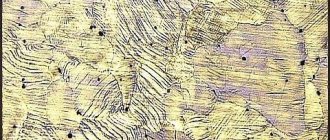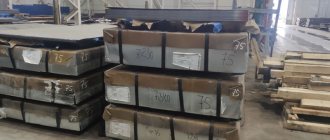| Brand: | P18 |
| Class: | High-speed tool steel |
| Used for rental: | Sections and shapes: GOST 19265-73, GOST 2590-2006, GOST 2591-2006 Calibrated rod: GOST 19265-73, GOST 7417-75 Ground rod and silver: GOST 19265-73, GOST 14955-77 Thick sheet: TU 14 -1-1408-75 Thin sheet: TU 14-1-1706-76, TU 14-1-1408-75 Strip: GOST 19265-73, GOST 4405-75 Wire: TU 14-1-1096-74 Forgings and forged workpiece: GOST 19265-73, GOST 1133-71. |
| Industrial use: | P18 steel is used to make cutters, cutters, drills, cutters, reamers, countersinks, taps, broaches and other cutting tools. |
| Material hardness: | HB 10-1 = 255 MPa |
| Critical point temperature: | Ac1 = 820, Ac3(Acm) = 860, Ar3(Arcm) = 770, Ar1 = 725 |
| Forging temperature, °C: | Start 1200, end 900. Cooling in wells at 750-800 °C |
| Cutting ability: | At HB 212-228 Kυ TV. spl. = 0.6 and Kυ b.st. = 0.3 |
| Weldability of material: | Welding is carried out without heating and without subsequent heat treatment (without restrictions). Good weldability during electric butt welding with steels 45 and 40X |
| Flock Sensitivity: | Not sensitive |
| Tendency to temper brittleness: | Less inclined |
| Analogues: | R9K5, R6M5, R6M5K5 |
Chemical composition of P18 steel
| Chemical element | % |
| Carbon (C) | 0,73 – 0,83 |
| Silicon (Si) | 0,2 – 0,5 |
| Manganese (Mn) | 0,2 – 0,5 |
| Nickel (Ni) | up to 0.6 |
| Phosphorus (P) | up to 0.03 |
| Chromium (Cr) | 3,8 – 4,4 |
| Molybdenum (Mo) | up to 1 |
| Tungsten (W) | 17 – 18,5 |
| Vanadium (V) | 1 – 1,4 |
| Cobalt (Co) | up to 0.5 |
| Sulfur (S) | up to 0.03 |
| Copper (Cu) | up to 0.25 |
| Iron (Fe) | ~73 |
Explanation of steel markings
The P18 quick cutter is marked when using certain standards. In the case under consideration, decoding allows one to determine only the tungsten content, the concentration of which is indicated digitally. The first letter defines the group of high-speed steels. The concentration of other chemical substances is determined by GOST and is not indicated when labeling the alloys of the group under consideration.
Explanation of high-speed steel markings
Physical properties of P18
| Test temperature, °C | 20 | 100 | 200 | 300 | 400 | 500 | 600 | 700 | 800 | 900 |
| Modulus of normal elasticity E, GPa | 228 | 223 | 219 | 210 | 201 | 192 | 181 | — | — | — |
| Density, pn, kg/cm3 | 8800 | — | — | — | — | — | — | — | — | — |
| Thermal conductivity coefficient W/(m °C) | — | 26 | 27 | 28 | 29 | 28 | 27 | 27 | — | — |
| Electrical resistivity (p, NΩ m) | 419 | 472 | 544 | 627 | 718 | 815 | 922 | 1037 | 1152 | 1173 |
| Linear expansion coefficient (a, 10-6 1/°С) | — | — | — | — | — | — | — | — | — | — |
| Specific heat capacity (C, J/(kg °C)) | — | — | — | — | — | — | — | — | — | — |
Characteristics and Application
When considering the characteristics of the P18 brand, it should be taken into account that it is often subjected to heat treatment. The main qualities include:
- High hardness of the surface layer. If heat treatment is carried out, the hardness reaches 62-65 HRC units. This is quite enough to cut structural metals of ordinary quality at various speeds and feeds. In addition to hardening, tempering is performed, due to which a fine-grained structure is achieved.
- Increased strength determines that the P18 material in question can withstand long-term loads.
- Red resistance allows cutting for a long period. An increase in the temperature of the steel leads to the fact that it begins to lose its performance characteristics.
Mechanical properties of P18 steel at elevated temperatures
Mechanical and physical properties of P18 steel
A significant drawback is carbide heterogeneity. When making large tools and using them, the cutting part may become chipped. The problem is solved by increasing the amount of carbide phase. The heat treatment carried out makes the structure fine-grained and more resistant to mechanical stress.
The use of P18 can be associated with the physical characteristics of the material. They are as follows:
- The density is 8800 kg/cm3.
- Elastic modulus 220 MPa.
- Hardness (without hardening) 227 HB.
- Maximum fluidity 450 MPa.
- Tensile strength 830 MPa.
Forging involves heating the workpiece to a temperature of 1200 degrees Celsius. The weldability of the alloy is good; there is no need to heat the material. The surface can be sanded using conventional abrasive wheels.
Hunting knife made of P18 steel
Chainsaw blade made of P18 steel
Self-tapping screws made of P18 steel
The scope of application of P18 steel is very wide. In most cases, it is used in the manufacture of cutting blade tools, which can be used for machining metals of varying hardness.
When using tools that are made from the tool alloy in question, the processing speed increases by 4 times.
The scope of application can be significantly expanded through hardening and tempering; in some cases, forging is carried out.
Mechanical properties of P18 depending on the tempering temperature
| Temperature, °C | 400 | 500 | 550 | 600 |
| Hardening 1280 °C, oil. Vacation three times for 1 hour | ||||
| σв (MPa) | 1370 | 1470 | 2350 | 2210 |
| KCU (J/cm2) | 23 | 19 | 17 | — |
| HRC ∂ (HB) | 61 | 63 | 66 | 65 |
Heat treatment P18
As previously noted, to significantly improve the performance characteristics of the material, heat treatment is carried out. The characteristics of the chemical composition determine which modes are used.
High speed steel P18 is improved as follows:
- During hardening, the workpiece is heated to a temperature of 1300 degrees Celsius. This is due to the fact that cobalt significantly increases the temperature of structural transformation. In order to eliminate the possibility of structural cracks, stepwise heating is carried out. The holding time depends on the thickness of the workpiece and its linear dimensions. Cooling of the workpiece is carried out in the open air in case of large sizes. Water is practically not used as a cooling medium, since uneven cooling leads to the appearance of surface and structural defects. Recently, oil has been used for cooling, which ensures uniform cooling.
- A fine-grained structure can be obtained by tempering at a temperature of 560 degrees Celsius. Cooling in this case is carried out in the open air.
After heat treatment, the possibility of improving the performance characteristics of the alloy should be considered. To do this, the chemical composition is changed during the following procedures:
- Sulfidation.
- Nitriding.
- Cyanidation.
- Steaming.
A similar improvement is also carried out after sharpening and polishing a cutting tool or other product. Due to this, the surface layer is given greater strength. Special equipment can be used to heat the workpiece and add chemicals. It is worth considering that the high heating temperature does not allow processing at home.
Mechanical properties of P18 steel in a heat-treated state at elevated temperatures
| Test temperature, °C | 200 | 400 | 500 | 550 | 600 | 650 |
| σben. (MPa) | 3570 (180) | 3730 (180) | 3290 (160) | 3060 (150) | 2430 (120) | 2180 (110) |
| H.V. | 815 (10) | 755 (10) | 712 (10) | 661 (10) | 615 (10) | 504 (10) |
| HRC ∂ (HB) | 64 | 62 | 60 | 58 | 56 | 51 |
Reviews
Anton, 35 years old: I have long dreamed of a good hunting knife, and my wife finally gave me a gift. We chose it together and was looking for the high-speed metal P18. I’ve already tried it in practice, the knife is comfortable, cuts ropes and branches well, and behaves tolerably when cutting game. So far I like everything.
Evgeniy, 28 years old: I bought a new knife because the one I got from my father broke. I chose for a long time and carefully studied the topic. I settled on a blade made of R6M5 steel because I wanted a knife that would last for decades without requiring weekly sharpening. I'm happy with the purchase, the knife is comfortable, heavy, fits well in the hand. There are no complaints about sharpening - the blade is sharp and cuts everything.
Previous
KnivesSteel spring 65G
Next
KnivesSteel U8: pros and cons for knives and its characteristics
Mechanical properties of P18 steel in the as-delivered condition (after annealing) at elevated temperatures
| Test temperature, °C | 200 | 400 | 600 | 800 | 1000 | 1100 | 1200 |
| σ0.2 (MPa) | 450 (50) | 420 (40) | 300 (40) | 110 (20) | 90 (20) | — | 30 (10) |
| σв (MPa) | 830 (80) | 700 (70) | 480 (50) | 200 (20) | 100 (20) | — | 30 (10) |
| δ5 (%) | 13 (2) | 15 (2) | 31 (3) | 60 (5) | 42 (4) | — | 12 (3) |
| ψ % | 22 (4) | 22 (4) | 55 (6) | 70 (6) | 55 (6) | — | 25 (5) |
| σcom. (MPa) | 1050 (50) | 850 (50) | 620 (40) | 100 (20) | 50 (10) | — | 40 (10) |
| Τk (MPa) | 520 (30) | 450 (30) | 300 (20) | 100 (20) | 50 (10) | — | 40 (10) |
| KCU (J/cm2) | — | — | — | — | 100 (10) | 130 (15) | 45 (5) |
| HB | 227 (6) | 210 (6) | 140 (6) | 30 (4) | 24 (4) | — | 4 (1) |
pros
- High quality . Products made from this steel will almost certainly be free of defects, due to the quality of the raw materials. Therefore, when buying a quick cutter from P18, you don’t have to worry.
- High hardness is very important for any cutting tool. And grade P18 has a hardness on the Rockwell scale from 65 to 64. For a knife, such hardness is considered very high, which classifies such a blade as a high-speed blade. It will very rarely have to be sharpened, because it does not become dull on ordinary materials - it can cut wood almost without hindrance.
- Good elasticity and impact strength due to additives . Usually, hard metal also turns out to be brittle - it is easy to break under lateral loads on the tool. But this alloy, as a rule, will bend, but not break, because some impurities, especially manganese and nickel, make it more flexible and ductile. Carbon and silicon not only add strength, but also protect against breakage. Therefore, saws and cutters are made from P18, which work great.
- The P18 blade has good cutting abilities , does not dull for a long time, and holds an edge well. The admixture of cobalt helps here, which is responsible for the cut. It helps the blade hold an edge, and also allows you to sharpen the blade to a razor sharpness, which it will maintain even during hard work.
- With this knife it will be possible to cut products made of softer materials . This alloy is traditionally used for metal cutting tools.
- In general, this type of steel can be considered almost perfectly balanced - it is distinguished by its hardness, is quite durable, and retains its cutting ability for a long time. Users note that of all high-speed steels, P18 is one of the best. The combination of all these properties makes it an ideal candidate for premium knife steel.
Cutting Application
Tool sharpening is 2-4 times faster when using P18 steel grade. It is used for the manufacture of cutting tools used in difficult conditions, including heating and high loads. This ensures that the basic technical characteristics of the products are preserved, which is an advantage. This parameter is necessary when creating automated workshops.
The high quality of the cut is due to the presence of alloying components in the material. Sharpening is carried out using emery wheels, but during the process it is important to eliminate dynamic and vibration effects.
Return to content
Production of cutting tools
The price of P18 steel is determined by the type of rolled product, taking into account the weight of the product and the volume of the order. One of the types of finished products is a drill, which is manufactured based on the requirements of State Standard 2034-80. These include the need to ensure a shank hardness of 63-68 HRC.
Grinding is the next stage after heat treatment. For this purpose, special machines are used that can guarantee compliance with the tolerances for the processed product - A1 and B1 according to h8, B - h9.
Return to content
Areas of use
Thanks to the above characteristics and low cost, 95X18 steel has found application in many branches of modern production.
Aviation instrument making uses this steel for the manufacture of critical components of mechanisms that are subject to increased wear resistance requirements. Parts made from 95Х18 are resistant to operation at ambient temperatures up to 500 ºС and moderate exposure to aggressive environments. First of all, this includes seating rings for rolling and sliding bearings.
In mechanical engineering, steel is actively used as a material for parts operating under conditions of abrasive wear. Its applications are extremely diverse and include all kinds of bushings, shafts, axles, hydraulic valves, springs, etc.
In the oil industry, 95X18 is used for the manufacture of roller and ball bearings.
95X18 steel is most widely used in the manufacture of bladed weapons.
The main modern knives used in hunting and tourism are usually made from two grades of steel. These are 95X18 and 65X13. Each of them has its own characteristics. There is still active debate on the forums of hunters’ websites about which one is better.
Steel 95x18 for knives: pros and cons
Advantages:
- First of all, it is worth noting the favorable ratio of the cost of knives and their performance characteristics. Their average price varies between 3,000 rubles.
- With more or less “competent” use, knives keep sharpening for up to 2 months.
- The sharpening process does not require high qualifications from the blade owner.
- These knives are characterized by high resistance to metal corrosion.
- Increased hardness and strength.
Flaws:
- Knives made from steel 95Х18 have a low impact toughness value. This can cause cracks to form when exposed to shock loads, or even split the knife. As a result, such blades are unsuitable for throwing.
- The performance characteristics of the blade strongly depend on the previously performed heat treatment. Steel is sensitive to the slightest deviations from the technology of its implementation. Although we note that in conditions of mass production, this operation is completely entrusted to specialized equipment, which reduces the appearance of low-quality products to nothing.
